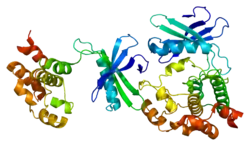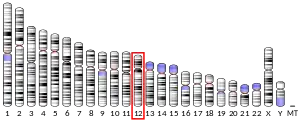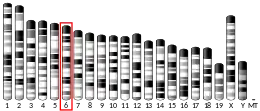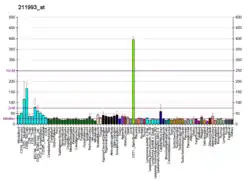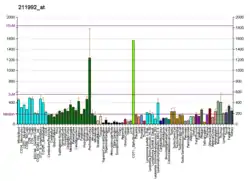WNK (lysine deficient protein kinase 1), also known as WNK1, is an enzyme that is encoded by the WNK1 gene.[5][6][7][8][9] WNK1 is serine-threonine protein kinase and part of the "with no lysine/K" kinase WNK family.[5][6][7][9] The predominant role of WNK1 is the regulation of cation-Cl− cotransporters (CCCs) such as the sodium chloride cotransporter (NCC), basolateral Na-K-Cl symporter (NKCC1), and potassium chloride cotransporter (KCC1) located within the kidney.[5][6][9] CCCs mediate ion homeostasis and modulate blood pressure by transporting ions in and out of the cell.[5] WNK1 mutations as a result have been implicated in blood pressure disorders/diseases; a prime example being familial hyperkalemic hypertension (FHHt).[5][6][7][8][9]
Structure
The WNK1 protein is composed of 2382 amino acids (molecular weight 230 kDa).[8] The protein contains a kinase domain located within its short N-terminaldomain and a long C-terminal tail.[8] The kinase domain has some similarity to the MEKK protein kinase family.[8] As a member of the WNK family, the kinase's catalytic lysine residue is uniquely located in beta strand 2 of the glycine loop.[8] In order to have kinase activity, WNK1 must autophosphorylate the serine 382 residue found in its activation loop.[8][5] Further, phosphorylation at another site (Ser378) increases WNK1 activity.[5] An autoinhibitory domain is located within the C-terminal domain along with a HQ domain that is needed for WNK1 interactions with other WNKs.[5][6][7][8] The interactions between WNKs play an important role in function; WNK1 mutants that lack an HQ domain also lack kinase activity.
Function
The WNK1 gene encodes a cytoplasmic serine-threonine kinase expressed in the distal nephron.[5][6][8] Studies have shown that WNK1 can activate multiple CCCs.[5][6] WNK1 however, does not directly phosphorylate the CCCs themselves rather it phosphorylates other serine-threonine kinases: Sterile20 related proline-alanine-rich kinase (SPAK) and oxidative stress response kinase 1 (OXSR1).[6][5][7] Phosphorylation of SPAK's T loop located in its catalytic domain will activate SPAK, which will go on to phosphorylation the CCC's N-terminaldomain.[5][6] Hence, WNK1 activates CCCs indirectly as an upstream regulator of SPAK/OSR1.[5][6][7]
Sodium reabsorption
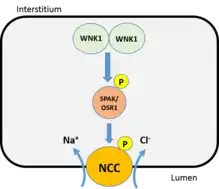
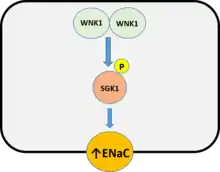
In the distal convoluted tubule (DCT), WNK1 is a potent activator of the NCC that results in an increase in sodium re absorption that drives an increase in blood pressure.[5][6][7] The WNK1 mutant found in FHHt harbors a large deletion within intron 1 that causes an increase in the expression of full length WNK1.[5][6][7][8] The boost in WNK1 leads to increases in NCC activation that promotes the high blood pressure/hypertension associated with FHHt.[5][6][7][8] WNK1 activates the serum-and glucocorticoid-inducible protein kinase SGK1, leading to increased expression of the epithelial sodium channel (ENaC), which also promotes sodium re absorption.[6]
Potassium secretion
WNK1 regulates potassium channels found in the cortical collecting duct (CCD) and connecting tubule (CNT).[6] Renal outer medullar potassium 1 (ROMK1) and large conductance calcium-activated potassium channel (BKCa) are the two primary channels for potassium secretion.[6] WNK1 indirectly stimulates clathrin-dependent endocytosis of ROMK1 by a potential interaction with intersectin (ITSN1); thus, kinase activity is not needed.[6] Another possible mechanism of ROMK1 regulation is via autosomal recessive hypercholesterolemia (ACH), which is a clathrin adaptor molecule.[6] ACH phosphorylation by WNK1 promotes the translocation of ROMK1 to clathrin coated pits triggering endocytosis.[6] WNK1 may indirectly activate BKCa by inhibiting the actions of extracellular signal–regulated kinases (ERK1 and ERK2) that lead to lysomal degradation.[6]
Cell volume regulation
The NKCC1/2 cotransporters are regulated by intracellular Cl− concentration.[9] Studies point to WNK1 as key effector that couples Cl− concentration to NKCC1/2 function.[5][9] In hypertonic (high extracellular Cl− ) conditions that trigger cell shrinkage, an unknown mechanism upregulates WNK1 expression to counteract the volume loss.[5] The increased WNK1 leads to activation of SPAK/OSR1 that activate NKCC1/2 via subsequent phosphorylation.[5][9] NKCC1/2 will promote the influx of Na+, K+, and Cl− ions into the cell thereby causing the flow of water into the cell.[5] In the reverse circumstances, where hypotonic (low extracellular Cl− ) conditions induce cell swelling, WNK1 is inhibited.[5] Another cotransporter, KCC is inactive when phosphorylated; without activated WNK1, KCC does not undergo phosphorylation and can activate.[5] The cotransporter will promote the efflux of K+ and Cl− ions and cause the flow of water out of the cell to combat swelling.[5]
WNK1 in the brain
In the mature brain, the GABA neurotransmitter represents the major inhibitory signal used in neuronal signaling.[5] GABA activates the GABAA receptor which is a Cl− ion channel.[5] Cl− ions will enter the neuron causing hyperpolarization and inhibition of signaling.[5] During brain development however, GABAA activation will allow Cl− ions to leave the neuron causing the neuron to depolarize.[5] Thus, GABA is an excitatory neurotransmitter during development.[5] WNK1 has been implicated in the developmental switch from excitatory to inhibitory GABA signaling via interaction with NKCC1 and KCCs.[5] WNK1 phosphorylates SPAK/OSR1 which then phosphorylates KCC2 inhibiting the flow of Cl− ions out of the cell during development.[5]
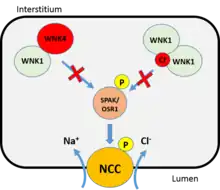
Regulation of WNK1
The concentrations of Cl− ions and K+ ion play a major role in regulating WNK1 activity.[5][9] In the DCT, the plasma concentration of K+ ion is thought to impact the concentration Cl− ions within the nephron.[5][9] High plasma K+ concentration down regulates WNK1 activity and prevents Cl− ion from entering the nephron via the NCC.[5][9] The opposite occurs when plasma K+ concentration is low; increased WNK1 activity boosts NCC activity promoting reabsorption of Cl− ions.[5][9] When there is an abundance of Cl− ions within the nephron, WNK1 activity is inhibited by the binding of a Cl− ion to WNK1's catalytic domain.[5][9]
Furthermore, WNK1 and WNK4 may interact to form heterodimers that inhibit WNK1 function.[7][6] WNK4 release from the heterodimer allows WNK1 monomer to bind another WNK1 monomer to promote activation.[6][7] WNK1 function can also be inhibited if WNK1 is degraded. There are two enzymes responsible for WNK1 ubiquitination, kelch like 3 (KLHL3) and cullin 3 (CUL3).[7][6][10] KLHL3 serves as an adaptor protein that promotes the interaction between WNK1 and Cullin3, which is in a complex containing an E3 ubiquitin ligase that attaches the ubiquitin molecules to WNK1.[7] The ubiquitinated WNK1 will subsequently undergo proteasomal degradation.[7][6][10]
Clinical significance
WNK1 has mutations associated with Gordon hyperkalemia-hypertension syndrome (pseudohypoaldosteronism Type II, featuring hypertension also called familial hyperkalemic hypertension (FHHt) )[5][7][8] and congenital sensory neuropathy (HSAN Type II, featuring loss of perception to pain, touch, and heat due to a loss of peripheral sensory nerves).[5][11]
Comparative genomics
The gene belongs to a group of four related protein kinases (WNK1, WNK2, WNK3, WNK4).[5][7][8]
Homologs of this protein have been found in Arabidopsis thaliana, C. elegans, Chlamydomonas reinhardtii and Vitis viniferaas well as in vertebrates including Danio rerio and Taeniopygia guttata.[7]
References
- 1 2 3 GRCh38: Ensembl release 89: ENSG00000060237 - Ensembl, May 2017
- 1 2 3 GRCm38: Ensembl release 89: ENSMUSG00000045962 - Ensembl, May 2017
- ↑ "Human PubMed Reference:". National Center for Biotechnology Information, U.S. National Library of Medicine.
- ↑ "Mouse PubMed Reference:". National Center for Biotechnology Information, U.S. National Library of Medicine.
- 1 2 3 4 5 6 7 8 9 10 11 12 13 14 15 16 17 18 19 20 21 22 23 24 25 26 27 28 29 30 31 32 33 34 35 36 37 38 Shekarabi M, Zhang J, Khanna AR, Ellison DH, Delpire E, Kahle KT (February 2017). "WNK Kinase Signaling in Ion Homeostasis and Human Disease". Cell Metabolism. 25 (2): 285–299. doi:10.1016/j.cmet.2017.01.007. hdl:10871/33390. PMID 28178566.
- 1 2 3 4 5 6 7 8 9 10 11 12 13 14 15 16 17 18 19 20 21 22 23 24 Hadchouel J, Ellison DH, Gamba G (2016). "Regulation of Renal Electrolyte Transport by WNK and SPAK-OSR1 Kinases". Annual Review of Physiology. 78: 367–89. doi:10.1146/annurev-physiol-021115-105431. PMID 26863326.
- 1 2 3 4 5 6 7 8 9 10 11 12 13 14 15 16 17 Bazúa-Valenti S, Gamba G (May 2015). "Revisiting the NaCl cotransporter regulation by with-no-lysine kinases". American Journal of Physiology. Cell Physiology. 308 (10): C779-91. doi:10.1152/ajpcell.00065.2015. PMC 4436992. PMID 25788573.
- 1 2 3 4 5 6 7 8 9 10 11 12 13 Xu BE, Lee BH, Min X, Lenertz L, Heise CJ, Stippec S, Goldsmith EJ, Cobb MH (January 2005). "WNK1: analysis of protein kinase structure, downstream targets, and potential roles in hypertension". Cell Research. 15 (1): 6–10. doi:10.1038/sj.cr.7290256. PMID 15686619. S2CID 22087578.
- 1 2 3 4 5 6 7 8 9 10 11 12 Huang CL, Cheng CJ (November 2015). "A unifying mechanism for WNK kinase regulation of sodium-chloride cotransporter". Pflügers Archiv. 467 (11): 2235–41. doi:10.1007/s00424-015-1708-2. PMC 4601926. PMID 25904388.
- 1 2 Alessi DR, Zhang J, Khanna A, Hochdörfer T, Shang Y, Kahle KT (July 2014). "The WNK-SPAK/OSR1 pathway: master regulator of cation-chloride cotransporters". Science Signaling. 7 (334): re3. doi:10.1126/scisignal.2005365. hdl:10871/33417. PMID 25028718. S2CID 206672635.
- ↑ Tang BL (July 2016). "(WNK)ing at death: With-no-lysine (Wnk) kinases in neuropathies and neuronal survival". Brain Research Bulletin. 125: 92–8. doi:10.1016/j.brainresbull.2016.04.017. PMID 27131446. S2CID 3938880.
